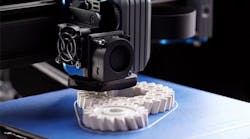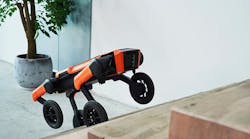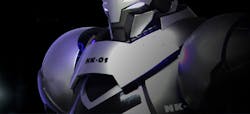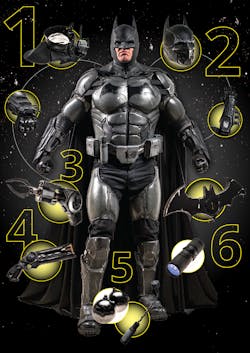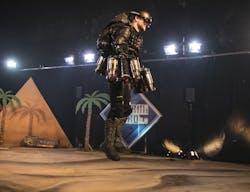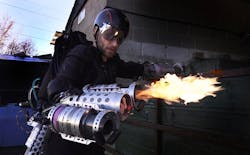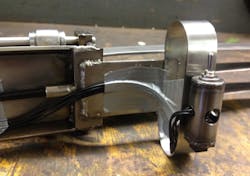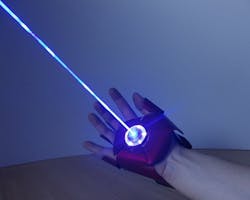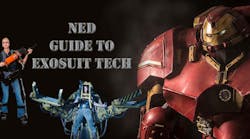Life imitates art far more than art imitates life. Oscar Wilde said that way back in his 1889 essay “The Decay of Lying,” and it still holds true today. No better example exists than how technology has been influenced by art, film, culture, and even comics.
“Star Trek” gave us mobile phones, inspiring Martin Cooper at Motorola. It also influenced John Carmack of id Software to make the holodeck real through 3D game engines. In fact, Carmack is at Oculus Rift right now still trying to make it real. Elon Musk, of Tesla and SpaceX fame, even admits to being influenced by comic books.
Consider ankle tracking devices, the system to raise ships from the bottom of the ocean, submarines, rockets, atomic power, tasers, Apple’s Quicktime, and countless other examples...they were all inspired by science fiction and comic books. Whether it’s the zeitgeist of the day or just people wanting cool things they see to be real, it’s happening all the time.
And the phenomenon is everywhere. Here are six fictional superhero technologies made real by unreal fans.
1. Iron Man Suit
It may look like War Machine, but FutureWise designates its “mecha-exosuit” as the NK-01. The robot system technology company hopes to mass-produce them once they finish the prototyping phase. As it sits now, the exosuit is powered by several servomotors to actuate its limbs—arms, hands, legs, and head—in true robotic form. LEDs on the suit’s chassis change color depending on the mood of the wearer. And yeah, you can “pilot” the suit from the inside in true Iron Man fashion.
Pilots housed inside will be able to see via an imaging system that uses cameras mounted in the suit’s head to pipe video to a screen positioned in front of the wearer. As far as others hearing your voice, communication is done through a built-in loudspeaker system that’s mounted to the front of the chest and controlled wirelessly.
In all fairness, the suit won’t give you super strength—if you couldn’t lift a car before the suit, you won’t be able to while wearing it. Nor will you get any cool, real-world weapons either. But what you will get are gazing crowds at every Comic-Con and cosplay convention you attend. FutureWise backs up that claim, as the company notes that the NK-01 is part of its “Entertainment Performance” product line.
2. Wolverine Claws
It was once thought inconceivable that anyone could upstage inventor Colin Furze and his incredible functioning Wolverine Claws (more on Furze later on), but apparently, that notion was wrong.
Brian Kaminski (of Advancer Technologies) has designed a set of claws that “snikt” just by flexing. His MyoWare Bionic Claws were designed to bring interest to his Kickstarter campaign for a new type of muscle sensor, which incidentally is how his claws function.
Brian is no stranger to designing awesome superhero-related gear, as he previously teamed up with Limbitless Solutions to design an Ironman-themed bionic limb for Alex Pring, a seven-year-old fan who was born with an underdeveloped arm. Amazingly enough, the gauntlet was presented to a delighted Alex by none other than Robert Downey Jr. himself. Brian’s original MyoWare sensor was used for that project and has since undergone its fourth revision, making it smaller and more sensitive—perfect for Bionic Claws.
The gauntlet-style design was created using a 3D-printed set of four-inch claws, which are connected to a servo horn that pushes and retracts based on muscle feedback information garnered from the sensor. Brian did a write-up tutorial on makezine.com so anyone can make their own bionic claws. He even throws in links for the source code for free!
3. Batman Suit
Vader hanging out with Batman? Vigilante vs. Sith Lord? Now that’s a movie worth seeing!
In actuality, though, the Batman suit in the above photo is outfitted with 23 functioning gadgets (a Guinness World Record for a cosplay suit) and was designed by special creature effects artist Julian Checkley. The suit was designed after the Batman: Arkham Origins video game, and while it won’t deflect bullets, it’s impressive nonetheless.
Checkley designed the costume using 3D-printed molds to cast the pieces in flexible urethane rubber, which were then painted and detailed before being attached to an under-suit. As far as gadgets go, the suit contains smoke bombs, a grapnel gun, a Bat Tracker (GPS unit), and a Bat Respirator (NBC mask).
The gadget list gets even better: Checkley actually enlisted the help of an electrical engineer to design some of the more complex goodies, such as a 2,000-watt EMP stun gun, a gauntlet-mounted fireball shooter with a pair of built-in video displays, a pneumatic tranquilizer gun, and an ultra-sonic anti-dog device. With so much crime-fighting gear packed into the suit, Checkley could have used Alfred’s help to put it on.
“This incredible cosplay suit is a great example of the eclectic records that appear in this year’s Gamer’s Edition 2017,” raved Guinness’ Stephen Daultrey. “The detail and imagination behind the gadgets take the meaning of cosplay to a whole new level.” Indeed so, Stephen. Indeed so.
4. Iron Man Jets
Google “real-life Iron Man suit” and Richard Browning comes up at the top of the list—and for good reason. His Daedalus jet engine suit is similar to Tony Stark’s creation, in that it gives the wearer the power of flight. The British oil trader and amateur inventor spent 18 months secretly designing and building the suit in his garage before finally unveiling his creation to the world earlier this year.
Instead of an Arc Reactor, Browning tasked three sets of kerosene-fueled micro-turbine engines (six in all) to achieve flight: two on each arm and two strapped to his back. A lightweight exosuit helps to provide some measure of stability while in the air, and a pair of ultra-light, snakebite-resistant boots provide protection against the heat exhaust from the jet engines (and possibly flying snakes).
To engage the engines, Browning uses a pair of triggers (one in each hand), with one controlling the jets on his arms and the other controlling those on his back. Control and stability are achieved strictly through his arm movements with pre-set engine power levels. Arms are held straight out before flight, and when you start to line them up with the ground, flight—or rather, hovering—is achieved.
The engines combine to produce around 286 pounds of thrust and allows Browning to remain in the air for about 12 minutes, and although he currently flies at 5 mph at an altitude of 3 to 6 feet, he thinks he may be able to push it to 60 mph and increase the altitude to 330 feet in the near future. He’s also continuing to develop the suit, with the latest addition being a HUD (Heads-Up Display) developed by Sony, which he uses to monitor fuel levels—a job previously handled by his wife and father-in-law’s facial expressions after squeezing the ground-based fuel tanks.
5. Wolverine Claws...Again
While Brian Kaminski’s version of Wolverine’s claws is impressive, to say the least, Colin Furze’s take on the beloved Marvel character’s arm-based weapons is incredible (and potentially lethal). Unlike Kaminski’s sensor-based design, Furze designed his claws to extend and retract using compressed air and a whole lot of engineering talent.
His design was based on trial and error of what worked and what didn’t. In the end, he went with a stainless steel rail system that uses metal rods and bearings to guide the steel blades in and out of “separation” channels that spread the claws apart when deployed, much like Wolverine’s. Air tanks worn on his back supply the compressed power need to actuate them and are controlled by a switch connected underneath the hand plate/guard.
Being the X-Men fan that he obviously is, Colin has brought some other superhero tech from the popular characters to life. Among these is a pair of Magneto magnetic shoes that are outfitted with powerful electromagnets (taken from trashed microwaves), allowing him to walk upside down on a metal ceiling. He also designed a pair of wrist-mounted flame-throwers based on the character Pyro using hand-controlled valves and fuel from a propane tank strapped to his back.
His take on Iceman is equally impressive and was designed in a similar fashion as his Pyro. Instead of propane strapped to his back, however, he uses a canister of liquid nitrogen that shoots out of a hand-mounted valve system to freeze objects on contact. Suffice it to say, recreating Furze’s designs could be potentially dangerous. Caution is advised.
6. Iron Man Gloves
Iron Man certainly is a popular Marvel character among engineers and inventors who look to recreate Stark’s tech, and Patrick Priebe is one of those fans who designed a pair of laser-based gauntlets based on the popular superhero. The first, designated as the “Iron Man Dual Laser Glove,” is an aluminum gauntlet that houses a 3,000 mW blue laser on the palm; it lights up using internal LEDs situated around the brass ring.
The top of the glove houses an 800 mW red laser as well as an aluminum projectile launcher that can actuate open and closed. A solenoid housed behind the top of the glove fires the projectile, while a pair of springs locks it in place when pushed back in. Priebe even included Iron Man’s repulse sound effects when the LEDs illuminate and he fires the lasers (talk about attention to detail).
Patrick’s second version, simply titled “Iron Man Gauntlet,” is an arm-mounted glove that mimics Iron Man’s micro-missile launching platform. He provides a disclaimer regarding the gauntlets design, stating it’s dangerous for others to recreate, and will offer no explanations of how he did so. Patrick does provide some details, however, including that the arm articulates open and closed using a button hidden inside the hand portion of the glove, revealing the rocket inside the gauntlet portion.
The tiny missile is actually a functioning hobby-style rocket that can be fired by pressing a button on the palm of the glove. Patrick also housed an internal 800 mW laser inside the arm portion to help with aiming said rocket, which tends to shoot off in random directions when fired horizontally. Regardless of the “classified” nature of the gauntlet’s design, it is an impressive homage to Tony Stark, and I’m doubtful it will be Patrick’s last—his designs always seem to coincide with the movie releases.
These examples are just several among thousands of superhero-inspired real-world designs that litter the internet. The creativity and ingenious solutions behind those gadgets are truly astounding, and as technology continues to become smaller and more user-friendly, it will be interesting to see what new superhero designs will come of it.

